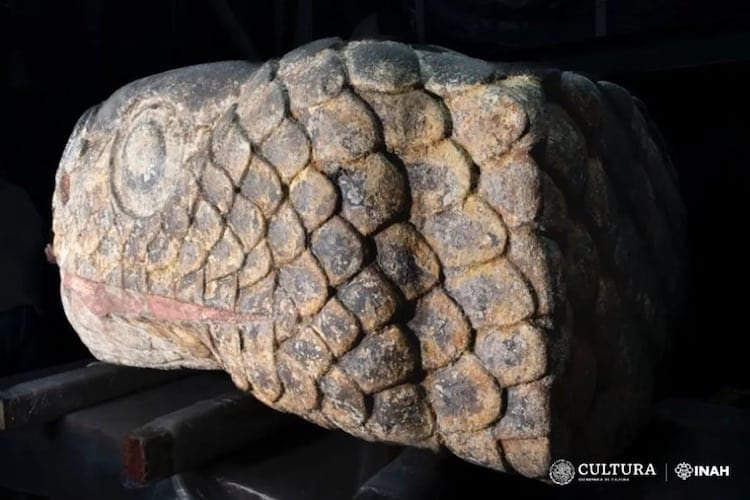On September 19, 2022, Mexico City experienced a powerful 7.7 magnitude earthquake. The earthquake caused significant damage to thousands of buildings, creating 2,000 aftershocks in its wake. But the earthquake did something else: it led to the unearthing of a long-lost piece of art. Buried beneath the ground near the city center, a 500-year-old sculpture was uncovered, revealing a direct link to the Aztec Empire.

Archaeologists from Mexico’s National Institute of Anthropology and History (INAH) recovered a stone measuring 1.8 meters long, 1 meter high and 85 centimetres wide. It depicts a giant snakehead meticulously carved, featuring a pair of eyes, a semi-open mouth and scales. About 80% of the surface still features red, blue and black pigments.
“These pigments, which represent a famous example of the color palette that the Mexica (the civilization also known as Aztecs) used to decorate their cult images and their temples, are extremely fragile due to the mineral and plant materials from which they were obtained,” Barajas Rocha, from the INAH, said in a news release.
An impressive snake (head)
The snake was removed from its original site through a crane. When discovered, it was 4.5 meters deep within the Tenochtitlan site – the ancient capital of the Aztec empire located at the site of modern Mexico City. Other snakehead sculptures had been previously found at Tenochtitlan but this one is especially striking because it still maintained its colors.
Frances Berdan, a professor of anthropology at California State University, San Bernardino, not involved in the study, told Live Science that the size and the artistry of the sculpture are impressive. However, he especially highlighted the survival of the colors, which allows getting “a good image of the visual impact” of such sculptures.
To preserve the colors as much as possible, the researchers have now placed the snake inside a humidity chamber and will work on color preservation until early 2024. They are optimistic that the accumulated moisture within the snake’s head, gathered over the centuries, will gradually dissipate without harming the stone’s surface finish.
“Our aim is for the snakehead to lose the moisture it has accumulated over the centuries slowly and carefully, so that it escapes from the internal pores of the rock to its surface, because if the process is accelerated it can lead to loss of colour and even cracking or crystallisation of salts in the stone,” Rocha said in a news release.
The Aztecs incorporated a multitude of serpents into their art, primarily influenced by deities like Quetzalcoatl, who was often depicted as a feathered serpent. However, it’s unclear if this newly-founded sculpture depicts him. Archaeologists will continue doing studies on the temporality, iconography and symbolism of the snake-looking sculpture.









